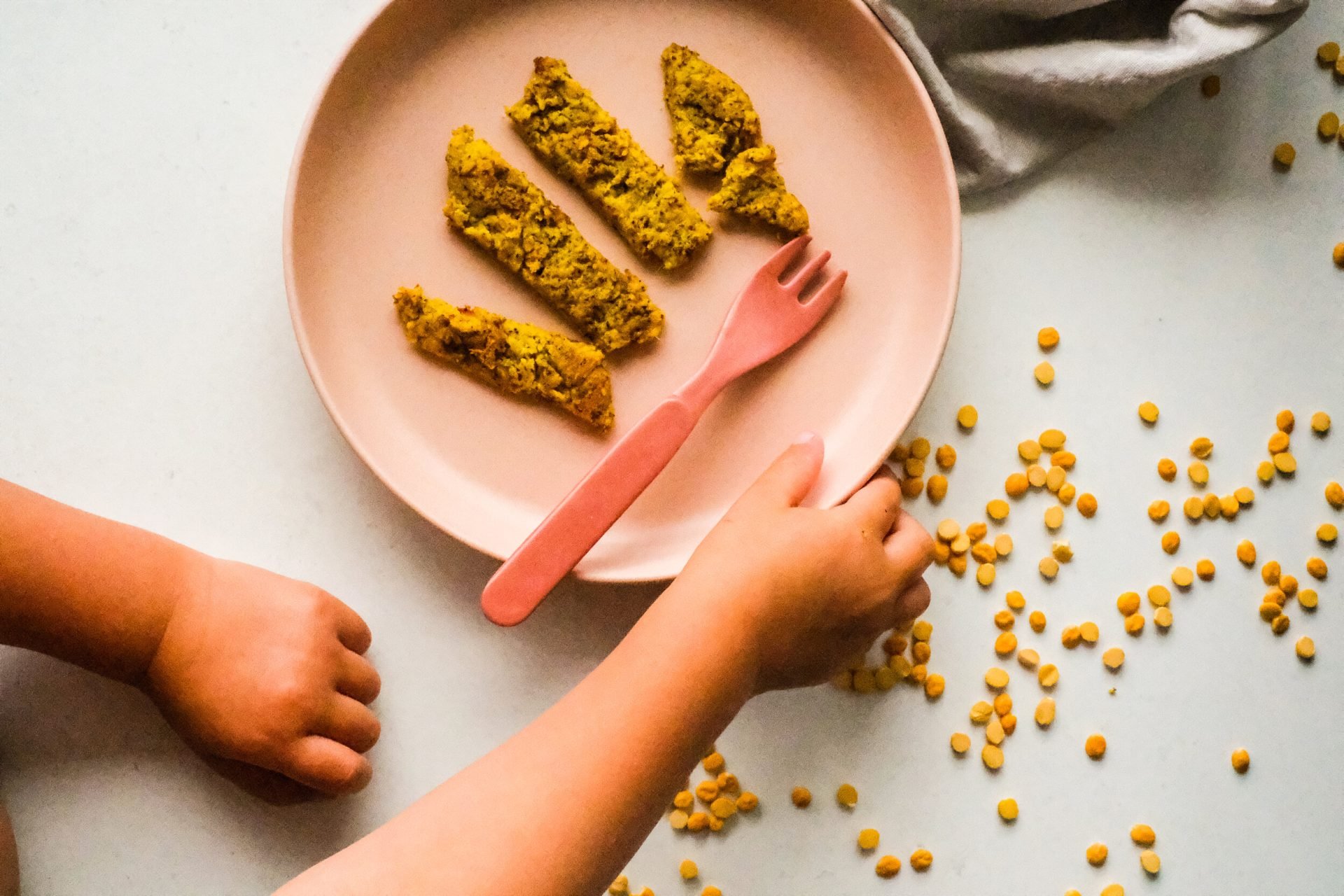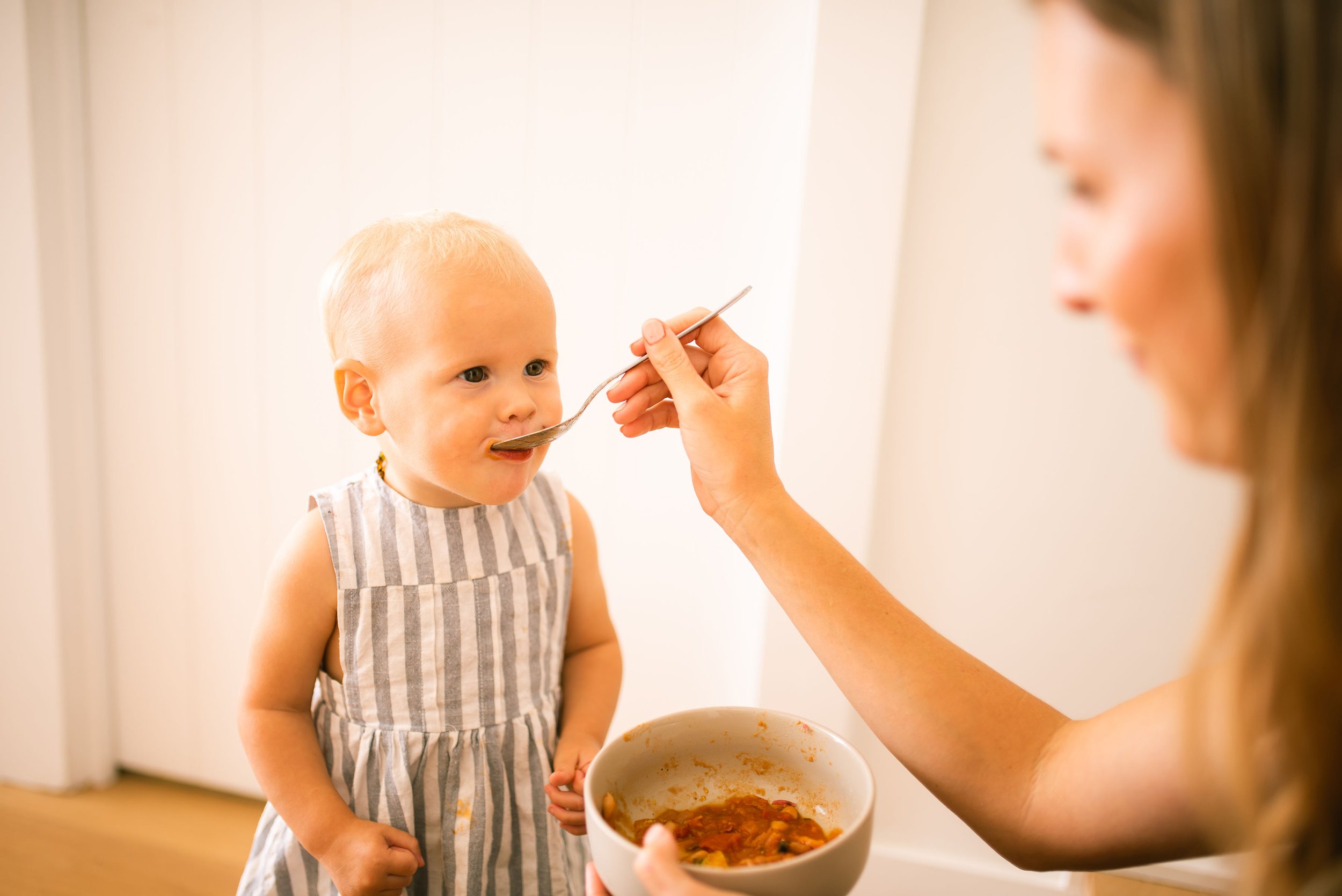If I had a dollar every time I have been asked this, i’d be very rich! The thing is, there is no right or wrong here, just like adults have different metabolisms, so do our babies, and learning to respect this is THE MOST IMPORTANT thing you can do in setting them up for healthy eating habits as they grow and develop!
Instead, I will share with you some foundations to understand how to recognise your babies hunger and fullness cues, so that you can practice responsive feeding with them, through learning ‘The Satter Division of Responsibility in Feeding’
Learning about what YOUR role is when it comes to offering your baby food is a game changer – it takes the pressure off of you and will create a more relaxed mealtime. Understanding your role early in your child’s feeding journey will set you and your child/children up for relaxed mealtimes to come, because the Division of Responsibility applies at every stage in your Childs growing up years!
The Division of Responsibility encourages to feed your baby on demand, letting him/her determine the timing and tempo of feeding. As he/she develops and becomes more regular in his/her eating patterns, you gradually take on responsibility for when and where to feed. Most children are ready to join in with the meals-plus-snacks routine of family meals by the end of the first year or the beginning of the second year. After that, your job is to maintain the structure of family meals and sit-down snacks throughout your child’s growing-up years. When you do your jobs with feeding, your child will do his/hers with eating.
So, to summarise, YOUR jobs with feeding are to . . .
-
Choose and prepare the food.
-
Provide regular meals and snacks.
-
Make eating times pleasant.
-
Step-by-step, show your child by example how to behave at family mealtime.
-
Be considerate of your child’s lack of food experience without catering to likes and dislikes.
-
Not let your child have food or beverages (except for water/breastmilk/formula) between meal and snack times.
-
Let your child grow into the body that is right for him.
Part of your feeding job is to trust your child to . . .
-
Eat.
-
Eat the amount he/she needs.
-
Learn to eat the food you enjoy.
-
Grow predictably in the way that is right for him/her.
-
Learn to behave well at mealtime.
‘Boob before food until 1 year old’
You may have heard this popular slogan, and it still remains true today. Breastmilk or formula is where your baby will obtain the majority of their nutrient needs in the first year and, therefore, should be offered prior to food. This is so that your baby does not fill up their daily calories on solids when breast or formula should still be the priority. Some people choose to milk feed before sleeps instead of on wake, and if this is how you feed your baby this is absolutely fine to continue, just be wary and mindful if they are starting to wean from the breast (not draining the breast/getting an exchange of milk) or not drinking much of their bottle as they used too) that they might be getting their main calories from food.
When your baby first starts solids, their intake may be quite small, so the amount of breastmilk or formula should remain the same. As your baby’s solid food intake increases, their breastmilk or formula consumption will gradually decrease, and you may notice your breastmilk supply gradually drop.
This will be a very gradual and very natural exchange.
So yes, they will start to naturally wean off as their food intake increases, but as a general rule of thumb, you would still expect them to have a milk feed in each awake period at the least until 12 months (and longer if you’re happy too). So for a 9-12 month old, that might look like a milk feed in the morning, one after their morning nap, one after their lunch nap & one before bed (and however many you’re lucky to have overnight!).
After 12 months, food can then be offered to your baby prior to or in replacement of their breastmilk/formula feed. This may slowly begin the natural process of weaning from milk feeds too solids. However, your baby will still reap the benefits of breastmilk as long as you and your baby wish to continue that journey!
*When offering your baby food, it’s best to offer it 30-60 minutes or so after their breast/formula feed, so that they’re neither too full, nor too hungry.
HOW OFTEN SHOULD I FEED MY BABY?
Every baby is different, and we would encourage you to accustom yourself with your baby’s feeding cues. Start solids by taking it slow, so as to not overwhelm their developing digestive system, and gradually increase as your baby leads the way.
This may include your baby asking verbally for food, pointing at food and/or wanting to eat your food.
The best time to start to introduce solids is around breakfast/morning tea/lunch; not dinner when they are overtired. So for a rough guide you might start with morning tea (after the first nap), for the second meal you might introduce an early dinner (after the second or third nap), and for the third meal you might introduce an early breakfast as the naps space out a bit and you have more time in the mornings! Again, this is a ROUGH guide – there is no right or wrong here.
The table below should act as a guide only. All babies are different and while some babies will jump to 3 meals a day quite quickly, others may take their time.
WHAT ABOUT SNACKS?
You walk down the baby aisle of the supermarket & are slammed with all those baby ‘snacks’ – puffs, yoghurt melts, rusks – but does your baby need them? You can barely fit in their meals around their milk feeds, naps, outings etc – how are you meant to fit snacks in too?
Well, despite some clever marketing making you think otherwise, babies under 12 months actually don’t NEED snacks!
And look, if some days your baby does snack – thats so fine & of course theres many times I will throw a cucumber at my son so I can just cook dinner – but I hear so many stories of child and family health nurses pushing 3 meals + 2 snacks for 9-12 month olds & so many parents/caregivers genuinely concerned how they can fit that much food in when they are still breast/formula feeding often without displacing their milk feeds!
As aforementioned, the priority is those milk feeds and their main meals, which at 9-12 months would be offering around 2-3 meals a day. Main meals are GENERALLY more nutritious than snacks – especially those packaged snacks that really contain little to no protein or fat which babies need!
If your baby is hungry between meals, offering their milk feeds can be a better alternative under 12 months – especially for a breastfeeding baby who may have many ‘snack’ feeds at this age (hello age of distraction!) so allowing them to breastfeed on demand can help them achieve that full feed (even if it takes 2-3 snack feeds to get there!). And just because its a main meal, doesn’t mean you can’t give it when out and about like you would a conventional ‘snack’.
HOW MUCH FOOD SHOULD I FEED MY BABY?
Our babies are all individuals; they all have different metabolisms, different energy requirements and different amounts they will want and need to eat, just like you.
For this reason, instead of focusing on an amount, it’s recommended to focus on your baby’s feeding and hunger cues.
Remember the Division of Responsibility – your job is “offering your baby food, not feeding your baby food.” Whether they eat the food or not is ultimately up to them! This is responsive feeding, which means you are responding to your baby’s cues, rather than on a fixed amount.
Generally, when starting out, the servings will be very small. Start with 1-2 tsp or one piece of finger food, and follow your baby’s lead. If baby demands more, you can then proceed to offer more.
The great thing about utilising the baby-led weaning method is that your baby will simply stop eating when they are no longer hungry and the risk of overfeeding is not an issue.
If you’re spoon-feeding, it is vital that you observe for signs of your baby’s fullness and their cues that meal time is over, instead of trying to keep offering ‘one more spoonful’.
Signs of disinterest may look like:
-
Baby turning their head away from the spoon
-
Hitting the spoon away
-
Becoming upset
-
Generally disinterested in the meal and not engaging with the meal
-
Shifting in their seat and wanting to get out
-
Starting to play more with their food than eat it
-
‘Windscreen wiping’ food around their tray
Be wary when increasing the amount of food per day that you do this gradually, as sometimes increasing fibre too quickly can cause constipation and digestive issues (read more about constipation here).
GUIDE TO STARTING SOLIDS, IN SUMMARY
To read more about starting your babies solids journey, check out this blog or you can purchase my book Milk to Meals which has EVERYTHING you need to know about starting solids + the recipes to put this information into practice!








+ show comments
- Hide Comments
add a comment